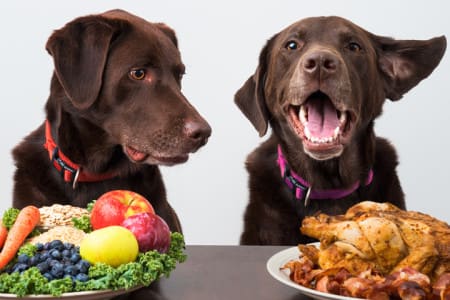Rocky’s Viewpoint

If you’re concerned about feeding the best possible diet to your dog, how do you determine that by comparing labels, if at all?
Reading and becoming familiar with the common terminology on dog food labels is one of the best ways to determine the quality of food you are feeding.

The first thing I always look at is the ingredient list.
Often you’ll see the Guaranteed Analysis section first, but frankly, I don’t pay a lot of attention to it.
I want to know what’s in the bag or the can.
All manufacturers must list the ingredients present in the food, and they must be listed in order of weight.
Typically, you always want a named protein source (chicken, for example) to be listed as the 1st ingredient and possibly 2nd ingredient. You also want that protein source to be a recognizable high quality meat, fish, or poultry product, not a by-product or something generic where you don’t really know what it is.
One thing to note is that a protein “meal” such as “chicken meal” listed on the label is always going to weigh less than chicken, because a meal product basically has had the water removed. There are situations where you would want one over the other, as long as it’s a high quality meal from a clearly identified source, such as chicken. Unfortunately, “meal” in dog food often implies a lower quality ingredient. When the label says “meat meal”, “animal meal” “chicken by-product meal”, “poultry meal”, or anything similar you can assume an inferior protein source.
Corn is a common ingredient, often listed in different forms in the first 5 ingredients in the list. While cereal grains such as corn may be OK for some dogs, it may not be for others. A lot depends on the quality of the grain and how it has been stored. Many dog food companies use low quality, cheap grains that are by-products of the human food industry, and have been classified as unfit for human consumption.
One other tactic from pet food manufacturers is to break down less desirable ingredients into several smaller ingredients so they appear farther down on the ingredient list, making it seem like there is less of that ingredient than there really is. A great example of this is corn broken down into ground corn, corn gluten meal, corn bran, corn germ meal, or corn starch-modified.

Fillers are various ingredients that provide little to no nutritional value, but are added in to provide dietary fiber. They are used by some pet food companies to fill the bag with a cheaper protein source.
Common fillers include rice bran, oat hulls, soybean hulls or soybean meal, brewers rice, peanut hulls, citrus pulp and more.
You’ll also notice on the label a nutritional statement that says whether the product meets AAFCO standards and how it was determined that it met the standards.
AAFCO stands for the American Association of Feed Control Officials. It is a non-profit organization that sets standards for pet foods in the US. If a food is marked “complete and balanced” it must meet AAFCO standards. There are 2 nutrient profile standards established by AAFCO:
There are 2 ways that food manufacturers can validate a claim that a food is complete and balanced according to AAFCO guidelines.
If a product was validated by laboratory analysis only, the food label will read “(Produce name) is formulated to meet the nutritional levels established by the AAFCO Dog Food Nutrient Profiles.”
If the product was validated by lab analysis and feeding trials, the label will read “Animal feeding tests using AAFCO procedures substantiate that (Product name) provides complete and balanced nutrition.”
Automatically, you would assume that doing feeding trials is a much better way to validate that a product meets the guidelines. But that’s not necessarily true. If one product in a particular food line was tested this way, and passed, the manufacturer is allowed to put this statement on all products in the same family, even if they weren’t tested. Also, the food is only required to be tested on 8 animals for 26 weeks, and only 6 of these animals need to complete the trial. There is no long term testing!
The label will also indicate whether the product is formulated for maintenance only, growth and reproduction only, or “all life stages.” If it states “all life stages”, the product meets the guidelines for both growth and reproduction, and adult maintenance.
If the food can’t meet either of the AAFCO profiles, the label will state “This product is intended for intermittent or supplemental feeding only.”
With all this being said, it’s important to note that AAFCO doesn’t regulate, test, approve or certify pet foods in any way. They only establish the nutritional standards for a complete and balanced diet, and it is up to the food manufacturer to formulate products that meet these standards.
Often, when products have a laundry list of ingredients that we often can’t pronounce and have no idea what they are, it’s because the manufacturer had to add those ingredients in order for the product to meet AAFCO guidelines. I would stay away from anything like this.
This part of the label gives you a recommendation on how much to feed, based on growth level and weight. They should be considered only as guidelines. If your dog is overweight, you want to feed the amount for the weight you want him to be, not the weight he currently is.
Also, you’ll notice that some foods require that you feed a lot more than other foods. This is an indication of a poor quality food. You must feed this amount in order to get the necessary daily nutrients. In a higher quality food, you feed less. While a higher quality food may be more expensive, since you have to feed less, the average cost per meal will be less.
We tell people to buy the best product they can based on their budget. There isn’t one right answer for every dog. Generally, a higher quality food will have less ingredients so we tell people to look for limited ingredients, and ingredients they understand and know what they are. The more you learn and know about what goes in to dog food, the better informed decision you can make.